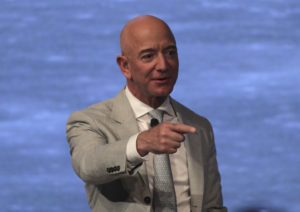The Outrageous Ascent of CEO Pay
The Securities and Exchange Commission just ruled that large publicly held corporations must disclose the ratios of their top executives' pay to the average pay of their workers. Shutterstock
Shutterstock
Shutterstock
This post originally ran on Robert Reich’s website.
The Securities and Exchange Commission just ruled that large
publicly held corporations must disclose the ratios of the pay of their top
CEOs to the pay of their median workers.
About time.
For the last thirty years almost all incentives operating on American corporations have resulted in lower pay for average workers and higher pay for CEOs and other top executives.
Consider that in 1965, CEOs of America’s largest corporations were paid, on average, 20 times the pay of average workers.
Now, the ratio is over 300 to 1.
Not only has CEO pay exploded, so has the pay of top executives just below them.
The share of
corporate income devoted to compensating the five highest-paid executives of
large corporations ballooned from an average of 5 percent in 1993 to more than
15 percent by 2005 (the latest data available).
Corporations might otherwise have devoted this sizable sum to research
and development, additional jobs, higher wages for average workers, or dividends
to shareholders – who, not incidentally, are supposed to be the owners of the
firm.
Corporate apologists say CEOs and other top executives are worth these amounts because their corporations have performed so well over the last three decades that CEOs are like star baseball players or movie stars.
Baloney. Most CEOs haven’t done anything special. The entire stock market surged over this time.
Even if a company’s CEO simply played online solitaire for thirty years, the company’s stock would have ridden the wave.
Besides, that stock market surge has had less to do with widespread economic gains that with changes in market rules favoring big companies and major banks over average employees, consumers, and taxpayers.
Consider, for example, the stronger and more extensive intellectual-property rights now enjoyed by major corporations, and the far weaker antitrust enforcement against them.
Add in the rash of taxpayer-funded bailouts, taxpayer-funded subsidies, and bankruptcies favoring big banks and corporations over employees and small borrowers.
Not to mention trade agreements making it easier to outsource American jobs, and state legislation (ironically called “right-to-work” laws) dramatically reducing the power of unions to bargain for higher wages.
The result has been higher stock prices but not higher living standards for most Americans.
Which doesn’t justify sky-high CEO pay unless you think some CEOs deserve it for their political prowess in wangling these legal changes through Congress and state legislatures.
It turns out the higher the CEO pay, the worse the firm does.
Professors Michael J. Cooper of the University of Utah, Huseyin Gulen of Purdue University, and P. Raghavendra Rau of the University of Cambridge, recently found that companies with the highest-paid CEOs returned about 10 percent less to their shareholders than do their industry peers.
So why aren’t shareholders hollering about CEO pay? Because corporate
law in the United States gives shareholders at most an advisory role.
They can holler all they want, but CEOs don’t have to listen.
Larry Ellison, the CEO of Oracle, received a pay package in 2013 valued at $78.4 million, a sum so stunning that Oracle shareholders rejected it. That made no difference because Ellison controlled the board.
In Australia, by contrast, shareholders have the right to force
an entire corporate board to stand for re-election if 25 percent or more of a
company’s shareholders vote against a CEO pay plan two years in a row.
Which is why Australian CEOs are paid an average of only 70 times the pay of the typical Australian worker.
The new SEC rule requiring disclosure of pay ratios could help
strengthen the hand of American shareholders.
The rule might generate other reforms as well – such as pegging corporate tax rates to those ratios.
Under a bill introduced in the California legislature last year, a company whose CEO earns only 25 times the pay of its typical worker would pay a corporate tax rate of only 7 percent, rather than the 8.8 percent rate now applied to all California firms.
On the other hand, a company whose CEO earns 200 times the pay of its typical employee, would face a 9.5 percent rate. If the CEO earned 400 times, the rate would be 13 percent.
The bill hasn’t made it through the legislature because business groups call it a “job killer.”
The reality
is the opposite. CEOs don’t create jobs. Their customers create jobs by buying
more of what their companies have to sell.
So pushing companies to put less money into the hands of their CEOs and more into the hands of their average employees will create more jobs.
The SEC’s disclosure rule isn’t perfect. Some corporations could try to game it by contracting out their low-wage jobs. Some industries pay their typical workers higher wages than other industries.
But the rule marks an important start.
Your support matters…Independent journalism is under threat and overshadowed by heavily funded mainstream media.
You can help level the playing field. Become a member.
Your tax-deductible contribution keeps us digging beneath the headlines to give you thought-provoking, investigative reporting and analysis that unearths what's really happening- without compromise.
Give today to support our courageous, independent journalists.






You need to be a supporter to comment.
There are currently no responses to this article.
Be the first to respond.